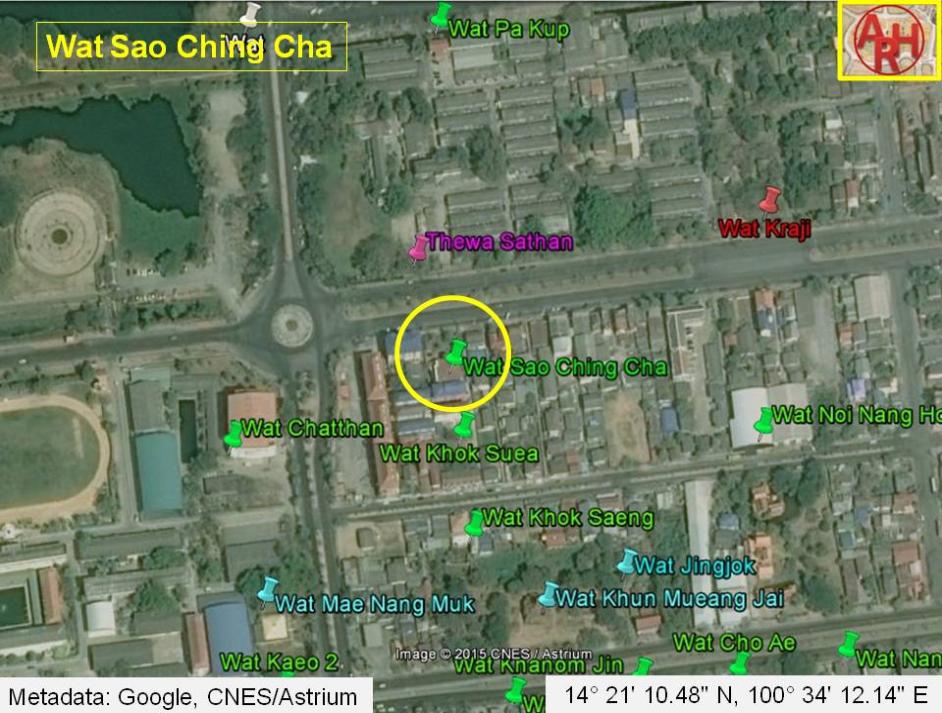| WAT SAO CHING CHA (วัดเสาชิงช้า) |

| Wat Sao Ching Cha or the Monastery of the Swing Post is a defunct temple formerly located on the city island in present Pratu Chai Sub-district, in the vicinity of the Chikun Bridge. This zone was the Brahman area of the city and the site must have been likely a Brahman temple. Following a map of the 19th century the monastery was situated on the east bank of Khlong Pratu Jin and partly along the road the French called 'Rue des Maures' or 'Moor Street', which is now more or less the present Pa Thon Rd (more or less as the ancient road did not have the width of the present lane). Wat Khok Rak (defunct) stood on its east, while Wat Khok Sua (defunct) stood in the south. Historical data about the monastery and its construction are unknown. The 19th century map indicates no existence of a chedi or prang. The temple is not mentioned on Phraya Boran Rachathanin's map drafted in 1926, though he mentions a location called Thewa Sathan. The name of the temple refers to a post or posts of a swing. It could as thus be that on this location a large swing was installed in ancient days to enact the Brahman rite Tri Yampawai. The swing was an enormous permanent erection between 25 and 30 meters high, which stood on a grassy plot in front of the Brahman temples. It consisted of a pair of great red-painted teak pillars, like ship's masts, which slope slightly inwards, and were joined at the top by carved cross-pieces. [1] It is possible that the location called Thewa Sathan by Phraya Boran Rachathanin on his map drafted in 1926, was part of the above temple. The construction of the present Pa Thon Rd, unfortunately made away with a lot of historic evidence. The swing must have been in the immediate vicinity of the Thewa Sathan shrine at par with the Bangkok Giant Swing built in 1784 and positioned in front of the Thewa Sathan shrine in Bangkok by order of King Rama I in order to observe yearly the Brahmin New Year Ceremony. (1) The ceremony was abolished in 1931 due to economic problems. (2) [2] Making an assessment of all the monastic structures, in the zone demarcated by Chikun Road, Pa Thon Road, Pridi Banomyong Road and U-Thong Road is rather difficult, as the position and name of the structures vary on different maps. On a 19th century map, there are 15 structures counted, while on the 20th century PBR map there are 13 mentioned. There is inconsistency in the names and the positions. Even maps drafted by the Fine Arts Department, what I presume, based on excavations in the zone, shed no light on this matter. Positions of monastic structures can be asserted, but their ancient names will remain questioned forever. Playing on the swing The important ceremony of Tri Yampawai Tripawai, popularly known as Lo Chin Cha (playing on the swing) was one of the most interesting of all Siamese State Ceremonies. None of the seventeenth century European writers mention this ceremony, with exception of Van Vliet, which was practiced in the Ayutthaya period. [3] The rite was performed to pay homage to Shiva as to commemorate the God's annual visit to the earth. Once a year the god Shiva comes down to visit this world and stays here for ten days. He used to arrive on the seventh day of the waxing moon in the first month and depart on the first day of the waning moon. As thus the Swinging Festival was performed in the first lunar month, but was changed in the Ratanakosin period to the second month. (3) It was not only an important State Ceremony in the former capitals of Ayutthaya and Sukhothai, but was practiced in the other chief cities of the realm in ancient times. [3] Though Jeremias Van Vliet wrote in his 'Short History of the Kings of Siam' in 1640, that the first swing was brought to Ayutthaya by two Brahmin priests during the reign of King Ramathibodi II (r. 1491-1529), the royal ceremony was likely already known since the Sukhothai period and still performed during the Ratanakosin era until the 1930's. [2] "The king of Ramaradt therefore sent two learned brahman priests with a letter in a friendly tone to the king of Siam asking that His Majesty forget all that had gone before and accept him as a brother. He also instructed the brahmans that they should make the game of schoppen or scbongelen known in Siam and to establish it there. The Siamese king accepted the brahmans, the letter, and the proffered peace, and sent a letter in reply establishing a friendship between both kings which has been maintained to the present day, renewed every two to three years by means of letters engraved in gold. Since then, various brahmans have come to Siam from many places, especially from Ramaradt, and have continued to be held in great esteem among the kings, princes, the royal family, and the community. At that time the Moorish traders from the Coromandel Coast came with their cloth, which practice continues to the present day. Scboppen or schongelen is still found today, because there are special places set out for playing it. There are special feast days held yearly which go on from one day to the next for a long time." [4] Quaritch Wales came to the conclusion that the 'swinging' was originally a solar ceremony. He stated that there were two ceremonies of swinging known in India, and both of these were of solar origin. His statement that the Siamese 'Lo Ching Cha' was originally a sun ceremony was based on the following characteristics: The 'swinging' occurred about the time of the winter solstice; It was performed from east to west, in the direction of the course of the sun. The swing-posts were oriented out of the plane of the transverse axis of the plaza in the centre of which they were situated so that the swinging should be performed exactly from east to west; and finally the circular dances which follow the swinging probably symbolize the revolution of the sun and its rebirth on the occasion of its return to the northern hemisphere. [5] The ceremony was originally a rite of imitative magic, intended to coerce the god Surya into the fulfillment of his functions. It was the 'to and fro' motion of the swing which impressed the ancients, as symbolizing the path of the sun. Quaritch wrote that - "The most noticeable and perhaps the earliest change that took place in the subsequent history of this ceremony was the substitution of Siva for Surya ... Surya was a Vedic god who sank to comparatively low estate in Brahmanic times, and, with the growth of Saivism, the original meaning of the ceremony was lost, and the Great God naturally came to usurp the place of the forgotten sun-god. The Swinging may have come to be regarded as symbolizing the functions of Shiva as Destroyer and Reproducer, and thus it would have retained its magical significance although now brought more closely into connection with agriculture as one of the many Hindu harvest festivals." According to Siamese notions, Shiva is a jovial god who likes to be amused; so the swinging and the acrobatic feats which accompany the procession are devised for his entertainment. The connection between swinging and harvest probably came into being before the arrival of the ceremony in Siam and it was probably never a purely solar ceremony in Siam. [5] During the Ayutthaya period the King remained in his palace on the occasion of the swinging ceremony. The King appointed the Minister of Agriculture to impersonate Shiva, and during the three days that the festival lasted this noble used to have almost unlimited powers and rights over certain of the State revenues. He was, in fact, a 'temporary king' or 'temporary god' the two terms being almost synonymous in Siam. The fact that the role of Shiva was performed by the Minister of Agriculture points to a connection with a harvest festival. [6] The Swinging festival was made to coincide with the new year of the Brahmans. Wat Sao Ching Cha must have been approximately located in geographical coordinates: 14° 21' 10.48" N, 100° 34' 12.14" E. Footnotes: (1) The remains of the original Bangkok 'swing' are now in the Bangkok National Museum, while the renovated swing was installed in front of Wat Suthat in 1920. [2] (2) Quaritch Wales wrote in 1930 that he was informed on high authority that the question of abolition was actually considered by the Supreme Council of State. He noticed there was little interest in the 'swinging, which meant absolutely nothing to the modern Siamese.' [1] (3) It was not difficult to postpone the date of his arrival until the second month; for, as the Brahmans, like the Pope, hold that they keep the keys of Heaven and, of course, Shiva could not come down till they had opened the door for him. [3]. References: [1] Siamese State Ceremonies - Their history and function - H.G. Quaritch Wales (1931) - page 240. [2] Old ceremonies to be revived as Giant Swing returns - The Nation - 10 Sep 2007. [3] Siamese State Ceremonies - Their history and function - H.G. Quaritch Wales (1931) - page 238. [4] Van Vliet's Siam - Chris Baker, Dhiravat Na Pombejra, Alfons Van Der Kraan & David K. Wyatt (2005) - page 212. [5] Siamese State Ceremonies - Their history and function - H.G. Quaritch Wales (1931) - page 245 [6] Ibid - page 239. |
| Text & maps by Tricky Vandenberg Updated May 2015 |
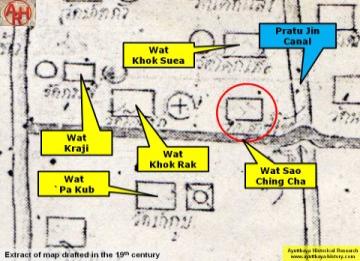
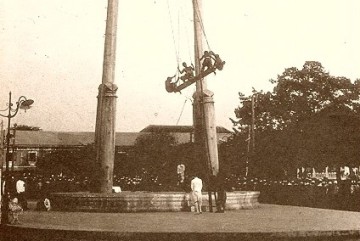
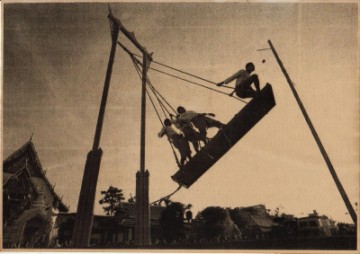

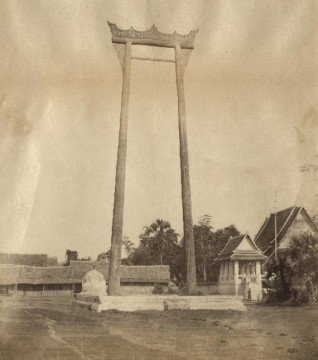
| (Young Brahmans swinged to the height of 25 m from the ground in an attempt to grab bags of coins, that were placed on top of a bamboo pillar. Some of the young men fell to death.) |
| (Detail of a 19th century map - map is orientated S-N) |

| (Detail of Phraya Boran Rachathanin's map - Anno 1926 - Thewa Sathan indicated as Brahmin Shrine) |
